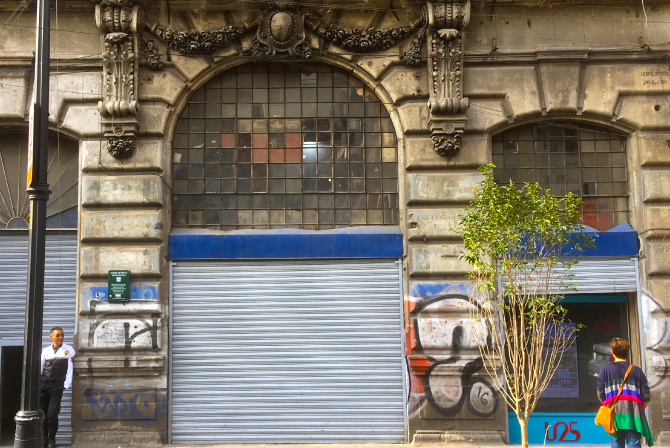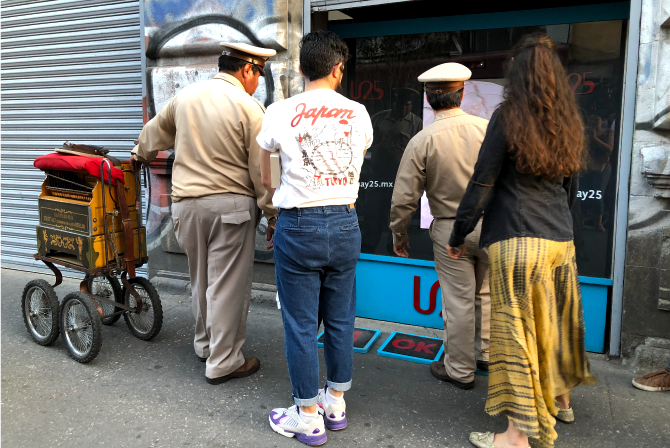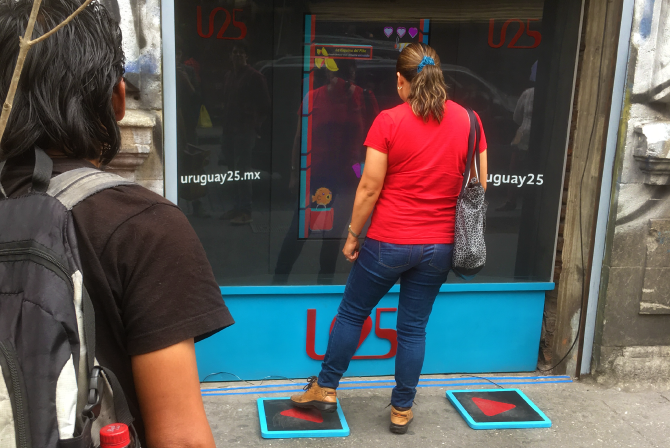




Uruguay 25
Uruguay 25 aims to recover, show and speculate about the different activities and social dynamics that surround a 100 year old building located in the number 25 on Uruguay Street at the Historic Downtown of Mexico City, emphasizing on the use of technology, symbolic appropriation and memory as tools to connect and engage with the different communities and individuals that inhabit the area. The work involved, among other activities, ethnographic research, the creation of an interdisciplinary and co-creative methodology, integration of ubiquitous computing and the development of a high-fidelity interactive prototype installed in the façade of the emblematic place, which is set to become a Culture and Experimentation Center in the following years.
The project was developed as the thesis for the master degree program in Information Design, and the result is the effort of an interdisciplinary team conformed by three members. My specific tasks in the research involved the creation of a design based methodology, which started by implementing ethnographic qualitative tools in the study area, including non-participatory observation and different stages of contextual interviews. This data led to the analysis of information, the creation of Personas and the application of Needfinding methods to identify the actions that could be developed on-site. Afterwards, the implementation of collaborative workshops and activities with the local community set the conceptual foundations of the co-designed installation and the decision of creating a playful window display (as a nod to the commercial context of the street).
These methodological steps led to development of the interactions for the object which included the planification of the on-screen contents, exploration of technological devices (Kinect camera, Arduino, sensors) and the creation of a visual proposal and graphic identity. The user experience evaluations were conducted in three different stages, with prototypes that ranked from low to high fidelity. The objective of the tests were to analyze the cognitive factors of the contents with different users, the pertinence of the visual information system and the functionality of the three interactives, which were developed to work as digital, tangible and ambient interfaces; these experimental interactions required the validation of different focus groups with varied technological backgrounds, as the challenge was to attract and engage any pedestrian with the installation in a short span of time and at the same time, create a memorable experience.
The final product surprises the spectators with its unexpected presence in the space, generating different behaviors, creating collective activities and inviting the pedestrians to step off from their daily routine. The visual contents of the ephemere exhibition are divided in three categories referencing the past, present and future of the street and showcase through different interactives the memories, tales, movements, flows, expectations and forecasts of the people from Uruguay Street. All the activities were generated and developed co-creatively with the different shop-owners, sellers and inhabitants of the area in order to involve them as creators and activists, by having their voices and opinions heard through the ludic object and propitiating the appropriation of the architectonic space.
Three interactives, which are portrayed on a large screen, merge the use of product and information design with the seamless application of hidden technological devices and ubiquitous computing to create a magic-like experience for the participants. The first one, invites the user to discover hidden messages from the past as they, unexpectedly, intervene images with their silhouette and alter the contents; the second one proposes an arcade style video game that takes over the street and incorporates tangible buttons on the sidewalk while the prizes and obstacles of the digital activity are fed through a network of sensors measuring different activities inside certain stores; the third one gives the participant the opportunity to create a digital intervention by drawing in the air with their hand over some pictures of the interiors of the building to present different ideas and expectations for crafting a collective future for the space, the block and, on a more ambitious scale, the city.
- Collaborators: Cristina Rivas, Pablo Sotres
- Client:Thesis project for the Master degree in Information Design
- Date:01/2018 - 10/2019
- Website: uruguay25.mx

